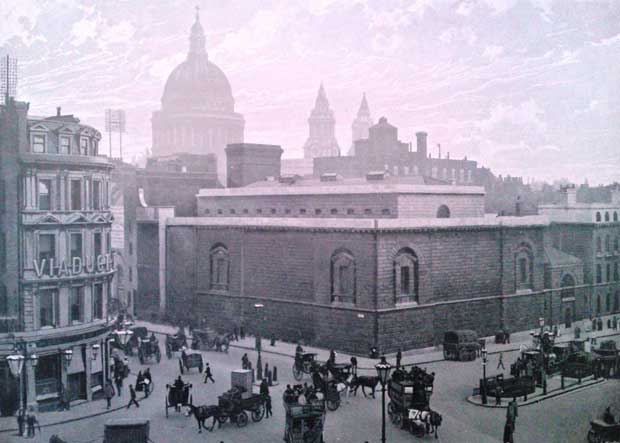Prior to the development of the Holborn Viaduct, as part of the Holborn valley improvement, the area on which it now stands was one of the most infamous criminal enclaves in London.
Indeed, so infamous was it that Charles Dickens chose it as the location of Fagin’s lair in Oliver Twist.
All manner of crimes took place here, including murder.
The Herts Guardian, in its edition of Saturday, 31st December 1864, featured the story of one such crime that had taken place in one of the enclave’s many taverns:-
MURDER IN LONDON
On Monday night four men were stabbed in the Golden Anchor public house, Saffron Hill, London, kept by Mr. Frederick Shaw.
It appears that, on Saturday night, some Italians were ejected from the house for making use of abusive language, and on Monday night, several of them entered the taproom for the avowed purpose of having their revenge.
DETECTIVE FAWELL CALLED IN
While there, they abused Englishmen who were there, broke the seats, and were proceeding to further acts of violence, when Mr. Shaw went to the door and called in Detective Fawell.
Before he got to the taproom loud cries of “Murder” were heard.
On Fawell going in, he found Italian, Serafino Polioni, a picture-frame maker, struggling with some men.
TAKEN INTO CUSTODY
At that moment Alfred Rebbeck, the potman, said he had been stabbed by Polioni, and blood was flowing from his right side.
Fawell took the man into custody, and he then ascertained that the prisoner had stabbed three other men, named Michael Harrington, Charley Bannister, and William King.
Rebbeck was found to be so dangerously stabbed that he was at once conveyed to the Royal Free Hospital, Gray’s Inn Road.
Mr. Hill, the resident medical officer, said the wound was so dangerous that the patient could not be expected to live.
On this Inspector Potter and Acting-Inspector Baldwin attended with the prisoner, and Rebbeck pointed him out as the person who had stabbed him.
The prisoner treated the matter with the greatest indifference.
HARRINGTON WAS ALSO DYING
Before the prisoner was removed from the Royal Free Hospital information was brought that Harrington was dying in St. Bartholomew’s Hospital. Upon proceeding there it was found that he had been stabbed very badly in the stomach.
HE FORGAVE HIM
He pointed out the prisoner as the man who had stabbed him; but, although his dying deposition was taken, Harrington said that he would not sign the paper, as he freely forgave the prisoner, and he hoped that God would too.
Harrington has since died.
REMANDED IN CUSTODY
The other two men stabbed by the prisoner, were attended at the Royal Free Hospital, but, although their wounds were very deep, they were not considered so dangerous as to make it necessary to detain them in the hospital.
Polioni was brought to the Clerkenwell Police Court, on Tuesday, charged with the wilful murder of Michael Harrington, and with feloniously cutting and wounding Alfred Bibbeck and Charles Bannister.
Some formal evidence was taken, and the prisoner was then remanded.
SENTENCED TO DEATH
The trial of Seraphini Polioni for the murder of Michael Harrington took place at the Central Criminal Court (Old Bailey) on the 30th of January 1865.
He was found guilty and was sentenced to death.

GREGORIO MOGNI CONFESSES
However, in March 1865, Gregorio Mogni came forward and confessed to the manslaughter of Michael Harrington, for which he was given five years penal servitude.
POLIONI’S RETRIAL
This meant that Polioni could not be executed for the crime he had been found guilty of, but it was stated that, although he had been proved guiltless of the murder of Michael Harrington, it was he who had stabbed the potman, Alfred Rebbeck
He was, therefore released from Newgate Prison, but was immediately re-arrested and, on Monday the 10th of April, 1865, he found himself back in the dock charged with having stabbed Alfred Rebbeck.
This time, however, the jury returned a verdict of “Not Guilty.”
